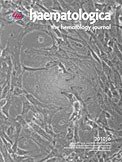Dickinson AM, Pearce KF, Norden J, O'Brien SG, Holler E, Bickeböller H, Balavarca Y, Rocha V, Kolb HJ, Hromadnikova I, Sedláček P, Niederwieser D, Brand R, Ruutu T, Apperley J, Szydlo R, Goulmy E, Siegert W, de Witte T, Gratwohl A. Haematologica. 2010 Jun;95(6):922–7. Epub 2010 Mar 19. IF: 6.416

Abstract:
Background: Non-HLA gene polymorphisms have been shown to influence outcome after allogeneic hematopoietic stem cell transplantation. Results were derived from heterogeneous, small populations and their value remains a matter of debate. Design and Methods: In this study, we assessed the effect of single nucleotide polymorphisms in genes for interleukin 1 receptor antagonist (IL1RN), interleukin 4 (IL4), interleukin 6 (IL6), interleukin 10 (IL10), interferon (IFNG), tumor necrosis factor (TNF) and the cell surface receptors tumor necrosis factor receptor II (TNFRSFIB), vitamin D receptor (VDR) and estrogen receptor alpha (ESR1) in a homogeneous cohort of 228 HLA identical sibling transplants for chronic myeloid leukemia. Three good predictors of overall survival, identified via statistical methods including Cox regression analysis, were investigated for their effects on transplant-related mortality and relapse. Predictive power was assessed after integration into the established European Group for Blood and Marrow Transplantation (EBMT) risk score. Results: Absence of patient TNFRSFIB 196R, absence of donor IL10 ATA/ACC and presence of donor IL1RN allele 2 genotypes were associated with increased transplantation-related mortality and decreased survival. Application of prediction error and concordance index statistics gave evidence that integration improved the EBMT risk score. Conclusions: Non-HLA genotypes were associated with survival after allogeneic hematopoietic stem cell transplantation. When three genetic polymorphisms were added into the EBMT risk model they improved the goodness of fit. Non-HLA genotyping could, therefore, be used to improve donor selection algorithms and risk assessment prior to allogeneic hematopoietic stem cell transplantation.
-az-
